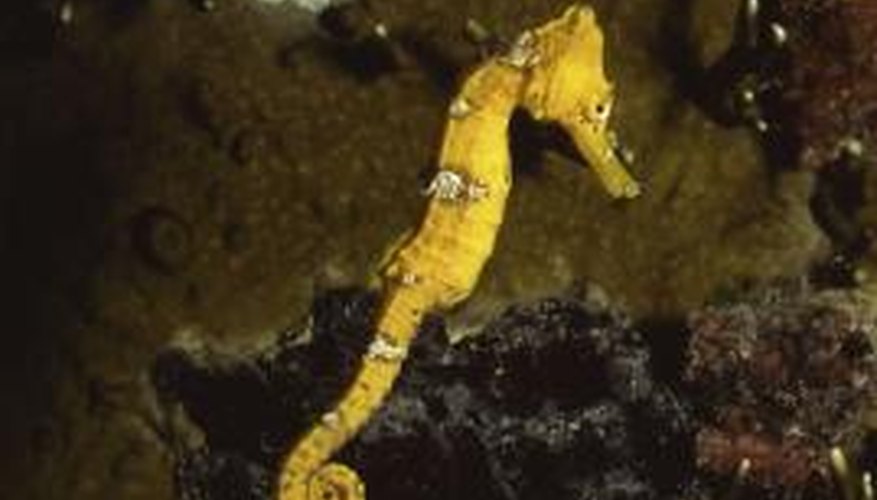As any saltwater aquarium enthusiast will tell you, there are some species that simply will not eat frozen, dried foods. One such species, the seahorse, will wither away from not eating and eventually die. For these types of animals, live mysis shrimp, a small saltwater crustacean, are used. Consequently, frequent trips to the pet store to purchase more shrimp is commonplace. It is possible, however, to breed mysis shrimp to have them readily available.
- As any saltwater aquarium enthusiast will tell you, there are some species that simply will not eat frozen, dried foods.
- One such species, the seahorse, will wither away from not eating and eventually die.
Fill 30-gallon tank with fresh water.
Add synthetic sea salt. The amount will vary depending on the brand and quality of the salt used.
Remove hydrometer (an instrument used to measure the specific gravity of salt water by displaying the ppt or "parts per trillion" of the water) from packaging and rinse with fresh water. Place it in the tank on a flat surface.
Within seconds, the floating arm on the hydrometer will stop at a certain number. You want the arm to rest between the numbers of 21 - 22 ppt (the numbers are imprinted on the hydrometer). If your hydrometer is above that number, drain some water from the tank, add fresh water and test again. If below that number, add more salt sparingly.
- Remove hydrometer (an instrument used to measure the specific gravity of salt water by displaying the ppt or "parts per trillion" of the water) from packaging and rinse with fresh water.
- You want the arm to rest between the numbers of 21 - 22 ppt (the numbers are imprinted on the hydrometer).
Be patient and continue testing as many times as you need to until you get the proper ratio.
Remove powerhead (this circulates the water) from packaging. Find the suction cup in the box and insert it onto the pump, a diagram for your specific powerhead will be included.
Place the powerhead on one side of the tank with the head pointing to the opposite side by pushing down on the suction cup. Water flow is imperative in successfully breeding mysis shrimp.
Place mesh separator in middle of tank.
Add algae or live rock to tank and allow three to four weeks for biological filter to be established.
- Remove powerhead (this circulates the water) from packaging.
- Add algae or live rock to tank and allow three to four weeks for biological filter to be established.
Add roughly 200 mysis shrimp to tank.
Pay close attention to the empty side of the tank. As babies are born, the powerhead will push them through the mesh separator, which screens out the adults.
Feed your adult mysis shrimp the live baby shrimp from your hatchery twice a day. Once some of the babies become adult size, move them back to adult side of the tank.
Cut off the bottom of your soda bottles and place them upside down into the plastic carton with caps tightly sealed.
- Pay close attention to the empty side of the tank.
- Cut off the bottom of your soda bottles and place them upside down into the plastic carton with caps tightly sealed.
Fill both bottles with tap water. Add one and a half to two tablespoons of synthetic sea salt. Allow the salt to completely dissolve before adding six to eight grams of brine shrimp eggs, available at your local aquarium store.
Open the air pump and attach airline tubing. Run the airline tubing about halfway down the soda bottle and clip on to rim of bottle (do not use air stone as it will cause foaming). Plug in air pump. You should see bubbles coming out of the air tube. Keep the hatching containers between 23.9 to 26.7 degrees Celsius.
Remove airline tubing from first bottle after 28 hours and let the contents settle.
- Open the air pump and attach airline tubing.
- Remove airline tubing from first bottle after 28 hours and let the contents settle.
Open cap on bottle and let the settled shrimp flow into the second bottle. Quickly put cap back on and begin process in first bottle again.
Use a brine shrimp net to collect shrimp you placed in second bottle.
Rinse the brine shrimp with fresh saltwater. The baby shrimp are now ready to be used as food for your mysis shrimp or other aquarium life.
TIP
Keeping a watchful eye on your mysis shrimp is imperative in successfully keeping them.
WARNING
Mysis shrimp are cannibalistic. If you do not feed them the brine shrimp on a regular basis, they will eat each other.
